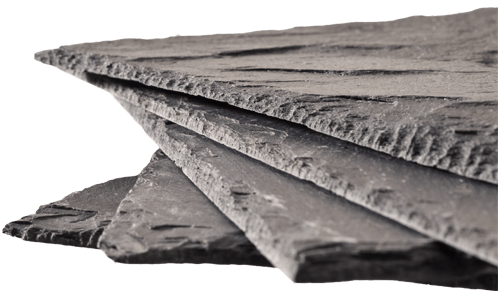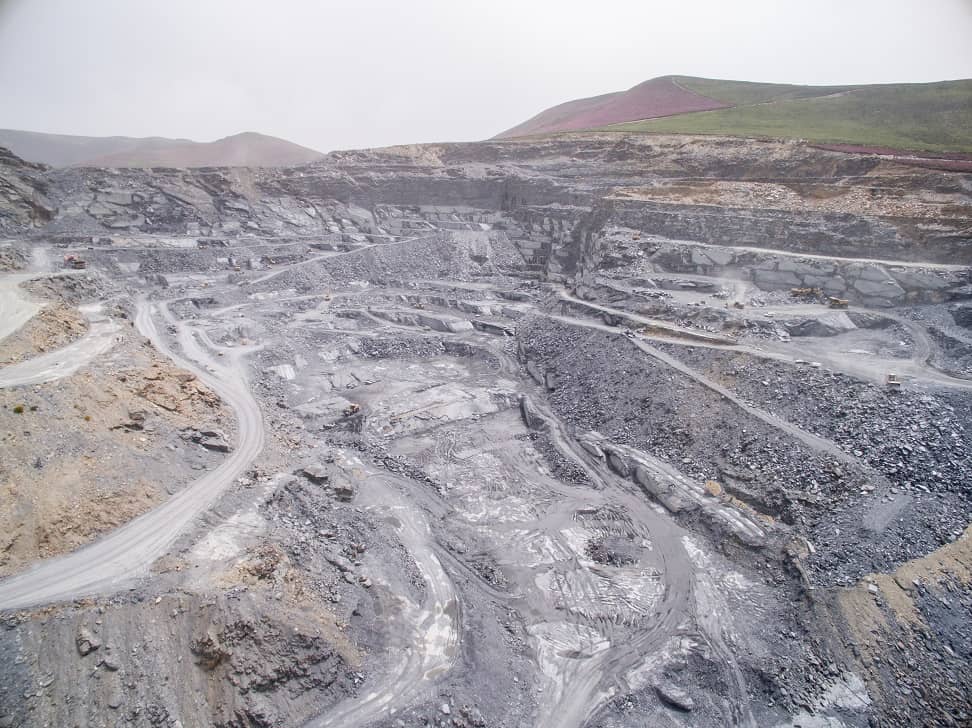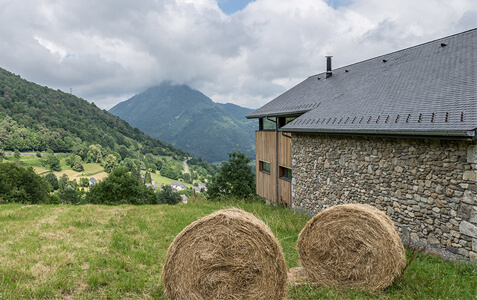Slate is a metamorphic rock of sedimentary origin, of Ordovician age (550 million years) and its main components are quartz, sericite and minerals from the chlorite group.
What is slate?
Is believed that the word “slate” comes from the Old French word scalar meaning fragment, from the verb slater, to shatter.
Slate is derived from fine-grained sediments such as mud or occasionally volcanic ash laid down millions of years ago in layers known as bedding. As the pile of sediments thickened, the original open structure of the mud was compacted into a mudstone or shale.
These rocks are easily split on the bedding planes and are referred to as flagstones. However, for a slate to form, subsequent intense geological forces associated with mountain building are required, during which the minerals present in the original mudstone are metamorphosed.
Some minerals, such as quartz grains, are flattened and stretched, while clay minerals are recrystallised as platy minerals: white mica and chlorite. The quartz minerals give the slate strength and durability, while the platy minerals form cleavage planes, which do not correspond to the bedding planes, but which allow the rock to be split into much thinner slabs suitable as roofing material. Differences in the composition of the original mudstone and the degree of metamorphism affect the quality of the slates thus produced.

The geology of slate
- Slate is a metamorphic rock of sedimentary origin.
- It dates from the Ordovician period (550 million years ago)
- Is mainly composed of quartz, sericite and minerals of the chlorite group.
- Has been used as a construction material since the ancient Egyptians.
- Its colour depends on the mineral structure and size of the mineral grains that define its composition.
Uses of Slate
Slate has a long tradition as a construction material. Slate is a natural, aesthetically pleasing stone. Its strength and outstanding resilience make it one of the most durable and versatile roofing materials.
The beauty of slate lies in the fact that it is a natural resource that requires little alteration from its natural form and offers a long lasting, pollutant resistant, fireproof, waterproof material with a warmth and elegance which places it in a league of its own.
Slate is mainly used for:
- Roofing: Most of the extracted slate is transformed for use as roofing material. The low rate of water absorption (less than 0.4%) as well as its great durability make this rock one of the most valued products for covering roofs.
- Facade cladding
- Flooring: Both indoors and for outdoor flooring.
- Decorative aggregate: garden decoration, wall cladding.
- Other uses: tables, countertops, plates for restaurants,…
What is the age of slate?
The age of the slate stone varies depending on the regional geology.
For example in Scotland, Ballachulish slate was formed from sediments laid down approximately 700 million years ago and was metamorphosed 500 million years ago, while Spanish slate from the Orense area was formed from muds laid down over 450 million years ago and was metamorphosed 300 – 350 million years ago.
Production process and exploitation areas
There are two natural slate extraction methods: open quarries and underground mines. In general, natural slate is surface quarried.
Here you can see an image of our Quarry 10 in Spain, called Las Arcas, which is the World’s largest slate quarry.

In the slate production process, there are no chemicals or additional treatments used, making it a 100% natural and an ecological material.
The most important deposits currently extracted are found in the Hercynian Mountain range that runs through Europe.
Spain is the country with the largest reserves of tectonic slate in the world. It is estimated that approximately 90% of the natural slate used in construction is obtained from Spain. In the northern region of Galicia and neighbouring provinces is where the largest number of mining operations are located.
These deposits are found on slate formations from the middle and upper Ordovician (from 485.4 million years ago to 443.8 million years ago) The most important are the geological structures of the Truchas Syncline (Orense and León) and the Caurel Syncline (Lugo and León).
Other countries with slate outcrops are:
- United Kingdom: Wales (Penrhyn Quarry).
- China.
- Brazil: 95% comes from the state of Minas Gerais.
- United States: Terranova, Vermont, New York (Slate Valley) and Virginia.
Slate characteristics
Slate as a roofing product is today unbeatable, from both a performance perspective and lasting aesthetics.
It is a natural material extracted directly from deposits with the utmost care to respect its properties as much as possible.
The only process that the raw material goes through is cutting which necessary to adapt it to the commercial format. It does not need any further treatment.

The color of slate depends on its mineralogical composition and its high-performance comes from its properties, among which waterproofing, resistance, durability and versatility stand out.
